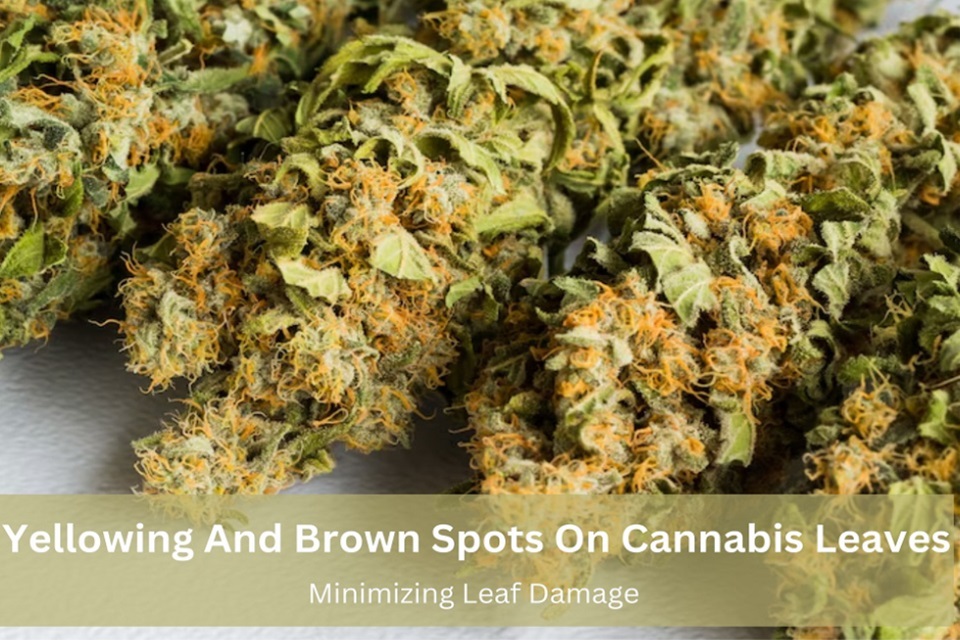
Cannabis cultivation can be a rewarding endeavor, but it comes with its challenges. One common issue that growers face is the yellowing and appearance of brown spots on cannabis leaves. Understanding the underlying causes of these problems is crucial for maintaining the health and vitality of your plants. In this article, we delve into the various factors contributing to yellowing and brown spots on cannabis leaves, offering insights and solutions to help you address these issues effectively.
Understanding Yellowing & Brown Spots
Yellowing and brown spots indicate underlying issues such as nutrient deficiencies, pH imbalance, over or underwatering, lighting problems, temperature fluctuations, or pest infestations. These issues can affect plant growth and reduce yield if not addressed promptly. By identifying the causes and implementing appropriate solutions, growers can ensure healthier and more robust cannabis plants, leading to better harvests and overall success in cultivation.
Minimizing Leaf Damage: Reasons & Solutions
Watering Practices & Effects On Cannabis Leaves
Improper watering practices, such as overwatering or underwatering, can lead to yellowing leaves. Lack of oxygen in the roots due to overwatering, while insufficient watering can lead to wilted and thin leaves.
Nutrient Deficiencies & Their Impact
A lack of essential nutrients, notably nitrogen deficiency, can result in the yellowing of leaves as the plant encounters difficulties obtaining vital nourishment. Ensuring a balanced nutrient supply is essential for preventing deficiencies and maintaining healthy foliage.
pH Balance & Its Role In Leaf Health
Ensuring the proper pH level of the water when watering cannabis plants is essential for optimal nutrient absorption. An imbalance in pH levels can impede the uptake of nutrients, resulting in leaf discoloration. Regular monitoring and adjustment of pH levels are vital for fostering robust foliage development.
Lighting Considerations For Leaf Health
Adequate lighting is crucial for maximizing plant growth. Overexposure to light may induce yellowing and leaf scorching, whereas insufficient light can result in lower leaf yellowing. Modifying the intensity and proximity of light sources can alleviate these concerns.
Temperature Management & Leaf Health
Extreme temperatures can also contribute to leaf yellowing. Heat stress can impede photosynthesis, while cold shock can lead the plant to wilt and appear yellow. Maintaining optimal temperature conditions is crucial for preventing these issues.
Pest Infestations & Leaf Damage
Pests pose a significant threat to cannabis plants, leading to weakened health, leaf yellowing, and evident signs of harm. Employing proactive measures and maintaining good hygiene can effectively reduce the likelihood of pest infestations.
Final Words
In conclusion, understanding the causes of yellowing and brown spots on cannabis leaves is essential for maintaining the health and vitality of your plants. By addressing issues such as improper watering, nutrient deficiencies, pH imbalance, lighting problems, temperature fluctuations, and pest infestations, growers can effectively manage these common problems. With proper care and attention to plant health, you can ensure the optimal growth and yield of your cannabis garden. Whether you’re a seasoned grower or just starting out, implementing these solutions will help you achieve healthier, happier plants.
FAQs
What is the optimal pH range for watering cannabis plants?
The optimal pH range is typically between 6.0 and 7.0 for cannabis plants to ensure proper nutrient absorption.
How do I know if my cannabis plants are experiencing heat stress?
Heat stress symptoms include wilting, yellowing leaves, and decreased growth in cannabis plants exposed to high temperatures.
What preventive measures can I take to avoid pest infestations in my cannabis garden?
Implement proper hygiene practices, limit access to the plants, and consider using insecticides specifically designed for cannabis plants to prevent pest infestations





